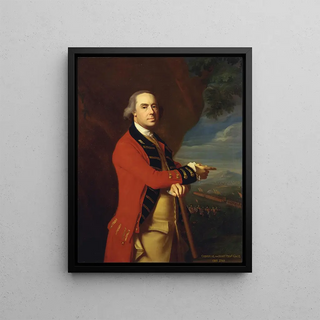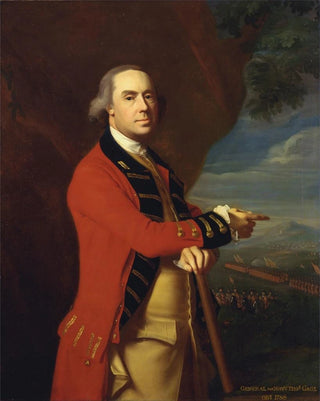Art print | General Thomas Gage - John Singleton Copley


View from behind

Frame (optional)
In the fascinating universe of art, some works stand out for their ability to capture historical moments while revealing the depth of the human soul. "Général Thomas Gage" by John Singleton Copley is one of these memorable creations. Painted in the 18th century, this iconic piece not only demonstrates the undeniable talent of its artist but also reflects an era marked by political and social upheavals. Copley, as a renowned portraitist, manages to immortalize the British general Thomas Gage, a key figure in American history, while infusing his painting with a psychological dimension that goes far beyond mere representation.
Style and uniqueness of the work
Copley's style is characterized by meticulous attention to detail and mastery of light play, which give his portraits a striking depth. In "Général Thomas Gage," every element, from the costume to the facial expression, is carefully crafted to create an image that is both realistic and symbolic. The general, depicted in a posture that suggests both authority and vulnerability, seems to question the viewer about his role in the tumultuous events of the time. The color palette chosen by Copley, with its rich nuances and subtle contrasts, enhances the emotional impact of the piece. This painting is not limited to a simple portrait; it is a reflection on power, duty, and the moral dilemmas faced by leaders.
The artist and his influence
John Singleton Copley, born in Boston in 1738, is often regarded as one of the greatest portraitists of his era. His career, marked by works that combine realism and psychological depth, profoundly influenced the development of American painting. Copley captured the spirit of his time by integrating elements of British culture while establishing himself within the emerging American context. His innovative approach to depicting figures, often imbued with dignity and complexity, paved the way for many artists who followed him. By painting historical figures like Thomas Gage, Copley not only documented history but also contributed

Matte finish

View from behind

Frame (optional)
In the fascinating universe of art, some works stand out for their ability to capture historical moments while revealing the depth of the human soul. "Général Thomas Gage" by John Singleton Copley is one of these memorable creations. Painted in the 18th century, this iconic piece not only demonstrates the undeniable talent of its artist but also reflects an era marked by political and social upheavals. Copley, as a renowned portraitist, manages to immortalize the British general Thomas Gage, a key figure in American history, while infusing his painting with a psychological dimension that goes far beyond mere representation.
Style and uniqueness of the work
Copley's style is characterized by meticulous attention to detail and mastery of light play, which give his portraits a striking depth. In "Général Thomas Gage," every element, from the costume to the facial expression, is carefully crafted to create an image that is both realistic and symbolic. The general, depicted in a posture that suggests both authority and vulnerability, seems to question the viewer about his role in the tumultuous events of the time. The color palette chosen by Copley, with its rich nuances and subtle contrasts, enhances the emotional impact of the piece. This painting is not limited to a simple portrait; it is a reflection on power, duty, and the moral dilemmas faced by leaders.
The artist and his influence
John Singleton Copley, born in Boston in 1738, is often regarded as one of the greatest portraitists of his era. His career, marked by works that combine realism and psychological depth, profoundly influenced the development of American painting. Copley captured the spirit of his time by integrating elements of British culture while establishing himself within the emerging American context. His innovative approach to depicting figures, often imbued with dignity and complexity, paved the way for many artists who followed him. By painting historical figures like Thomas Gage, Copley not only documented history but also contributed






